Salisbury Cathedral
Salisbury Cathedral, formally known as the Cathedral Church of the Blessed Virgin Mary, is an Anglican cathedral in Salisbury, England. The cathedral is regarded as one of the leading examples of Early English architecture.[3] Its main body was completed in 38 years, from 1220 to 1258.
| Cathedral of the Blessed Virgin Mary, Salisbury | |
|---|---|
| Cathedral of Saint Mary | |
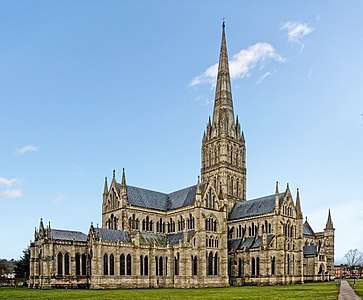 Salisbury Cathedral from the East | |
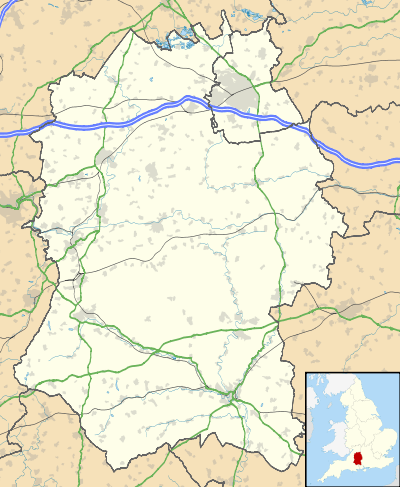 Cathedral of the Blessed Virgin Mary, Salisbury Location within Wiltshire | |
| Location | Salisbury, Wiltshire |
| Country | England |
| Denomination | Church of England, formerly Roman Catholic Church |
| Tradition | Anglo-Catholic[1] |
| Website | salisburycathedral |
| Architecture | |
| Previous cathedrals | 2 |
| Architect(s) | Richard Poore; Elias of Dereham |
| Style | Early English Gothic |
| Years built | 1220–1320 |
| Specifications | |
| Length | 442 feet (135 m) |
| Nave length | 234 feet (71 m)[2] |
| Nave width | 78 feet (24 m)[2] |
| Choir height | 84 feet (26 m) |
| Number of towers | 1 |
| Tower height | 225 feet (69 m) (without spire) |
| Number of spires | 1 |
| Spire height | 404 feet (123 m) |
| Administration | |
| Diocese | Salisbury (since 1220) |
| Province | Canterbury |
| Clergy | |
| Bishop(s) | Nick Holtam |
| Dean | Nicholas Papadopulos |
| Precentor | Anna Macham |
| Canon Chancellor | Ed Probert |
| Canon Treasurer | Robert Titley |
| Laity | |
| Organist(s) | John Challenger, David Halls |
| Chapter clerk | Jackie Molnar |
| Lay member(s) of chapter | Jane Barker Luke March Lydia Brown Eugenie Turton |
Since 1549, the cathedral has had the tallest church spire in the United Kingdom, at 404 feet (123 m).[4] Visitors can take the "Tower Tour", in which the interior of the hollow spire, with its ancient wooden scaffolding, can be viewed. The cathedral has the largest cloister and the largest cathedral close in Britain at 80 acres (32 ha).[3] It contains a clock which is among the oldest working examples in the world, and has the best surviving of the four original copies of Magna Carta. In 2008, the cathedral celebrated the 750th anniversary of its consecration.[5]
The cathedral is the mother church of the Diocese of Salisbury and is the seat of the Bishop of Salisbury, currently Nick Holtam.
History
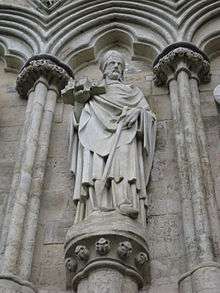

As a response to deteriorating relations between the clergy and the military at Old Sarum Cathedral, the decision was taken to re-site the cathedral, with the seat of the bishopric being moved to New Sarum, or Salisbury.[6] The move occurred during the tenure of Richard Poore, a rich man who gave the land on which the new cathedral was built.
Construction was paid for by donations, principally from the canons and vicars of southeast England, who were asked to contribute a fixed annual sum until the building was completed.[7] A legend tells that the Bishop of Old Sarum shot an arrow in the direction he would build the cathedral; the arrow hit a deer, which died in the place where Salisbury Cathedral is now. The cathedral crossing, Old Sarum, and Stonehenge are reputed to be aligned on a ley line, although Clive L. N. Ruggles asserts that the site, on marshland, was chosen because a preferred site several miles to the west could not be obtained.[8]
The foundation stones were laid on 28 April 1220 by William Longespée, 3rd Earl of Salisbury and by Ela of Salisbury, 3rd Countess of Salisbury.[9][10] Much of the freestone for the cathedral came from the Teffont Evias Quarry.[11] As a result of the high water table on the new site, the cathedral was built on foundations only 4 feet (1.2 m) deep, and by 1258 the nave, transepts, and choir were complete. The only major sections begun later were the cloisters, added in 1240, the chapter house in 1263, the tower and spire, which at 404 feet (123 m) dominated the skyline from 1320. Because most of the cathedral was built in only 38 years, it has a single consistent architectural style, Early English Gothic. In total, 70,000 tons of stone, 3,000 tons of timber and 450 tons of lead were used in the construction of the cathedral.[12]
Although the spire is the cathedral's most impressive feature, it has proved troublesome. Together with the tower, it added 6,397 tons (6,500 tonnes) to the weight of the building. Without the addition of buttresses, bracing arches and anchor irons over the succeeding centuries, it would have suffered the fate of spires on other great ecclesiastical buildings (such as Malmesbury Abbey, 1180 to 1500; Lincoln Cathedral, 1311 to 1549; and Chichester Cathedral, 1402 to 1861) and fallen down; instead, Salisbury became the tallest church spire in the country on the collapse at Lincoln in 1549. The large supporting pillars at the corners of the spire are seen to bend inwards under the stress. The addition of reinforcing tie-beams above the crossing, designed by Christopher Wren in 1668, halted further deformation.[13] The beams were hidden by a false ceiling installed below the lantern stage of the tower.
Significant changes to the cathedral were made by the architect James Wyatt in 1790, including the replacement of the original rood screen and demolition of a bell tower which stood about 320 feet (98 m) northwest of the main building. Salisbury is one of only three English cathedrals to lack a ring of bells, the others being Norwich Cathedral and Ely Cathedral. However, its medieval clock does strike the time with bells every 15 minutes.
21st century
In February 2016, the cathedral chapter placed Sophie Ryder's sculpture The Kiss straddling a path on the grounds where it was to remain until July. After only a few days, the work had to be moved, as pedestrians kept bumping into it while texting.[14]
On 25 October 2018, there was an attempted theft of Magna Carta from the cathedral; the alarms were triggered and a 45-year-old man was later detained on suspicion of attempted theft, criminal damage and possession of an offensive weapon. The outer layer of a double-layered glass case containing the document was broken, but the document suffered no damage.[15] In January 2020 the perpetrator, Mark Royden, aged 47, from Kent, was found guilty of the attempted theft, which caused £14,466 of damage, and guilty of criminal damage.[16]
Building and architecture
West front
The west front is of the screen-type, clearly deriving from that at Wells. It is composed of a stair turret at each extremity, with two niched buttresses nearer the centre line supporting the large central triple window. The stair turrets are topped with spirelets, and the central section is topped by a gable which contains four lancet windows topped by two round quatrefoil windows surmounted by a mandorla containing Christ in Majesty. At ground level there is a principal door flanked by two smaller doors. The whole is highly decorated with quatrefoil motifs, columns, trefoil motifs and bands of diapering.
The west front was almost certainly constructed at the same time as the cathedral.[17] This is apparent from the way in which the windows coincide with the interior spaces. The entire facade is about 108 feet (33 m) high and wide. It has been said that the front was built on a scale smaller than was initially planned. It lacks full-scale towers and/or spires as can be seen, for example at Wells, Lincoln, Lichfield, etc.[18] The facade was disparaged by Alec Clifton-Taylor, who considered it the least successful of the English screen facades and a travesty of its prototype (Wells). He found the composition to be uncoordinated, and the Victorian statuary "poor and insipid".[19]
The front accommodates over 130 shallow niches of varying sizes, 73 of which contain a statue. The line of niches extends round the turrets to the north, south and east faces. There are five levels of niches (not including the mandorla) which show, from the top, angels and archangels, Old Testament patriarchs, apostles and evangelists, martyrs, doctors and philosophers and, on the lower level, royalty, priests and worthy people connected with the cathedral. The majority of the statues were placed during the middle of the 19th century, however seven are from the 14th century and several have been installed within the last decade.
Nave

Salisbury Cathedral is unusual for its tall and narrow nave, which has visual accentuation from the use of light grey Chilmark stone for the walls and dark polished Purbeck marble for the columns. It has three levels: a tall pointed arcade, an open gallery and a small clerestory.[20] Lined up between the pillars are notable tombs such as that of William Longespée, half brother of King John and the illegitimate son of Henry II, who was the first person to be buried in the cathedral.[21]
Another unusual feature of the nave is an unconventional modern font, installed in September 2008.[22] Designed by the water sculptor William Pye, it is the largest working font in any British cathedral, and replaced an earlier portable neo-Gothic Victorian font. The font is cruciform in shape, and has a 10-foot-wide vessel filled to its brim with water, designed so that the water overflows in filaments through each corner into bronze gratings embedded in the cathedral's stone floor. The project cost £180,000 and was funded entirely by donations. Some parishioners reportedly objected to the new font, considering it 'change for change's sake', although Pye argued that the majority opinion was in favour: "I would say 90 per cent are in happy anticipation, five per cent are nervously expectant and five per cent are probably apoplectic".[23]
Chapter house and Magna Carta
The chapter house is notable for its octagonal shape, slender central pillar and decorative medieval frieze. It was redecorated in 1855–9 by William Burges. The frieze, which circles the interior above the stalls, depicts scenes and stories from the books of Genesis and Exodus, including Adam and Eve, Noah, the Tower of Babel, and Abraham, Isaac and Jacob.
The chapter house displays the best-preserved of the four surviving original copies of Magna Carta.[24] This copy came to Salisbury because Elias of Dereham, who was present at Runnymede in 1215, was given the task of distributing some of the original copies. Elias later became a canon of Salisbury and supervised the construction of the cathedral.
Clock
The Salisbury Cathedral clock, which dates from about AD 1386, is supposedly the oldest working modern clock in the world.[25] The clock has no face; all clocks of that date rang out the hours on a bell. It was originally located in a bell tower that was demolished in 1792. Following this demolition, the clock was moved to the Cathedral Tower, where it was in operation until 1884. The clock was then placed in storage and forgotten until it was discovered in an attic of the cathedral in 1928. It was repaired and restored to working order in 1956. In 2007, remedial work and repairs were carried out.[26]
Depictions in art, literature and television
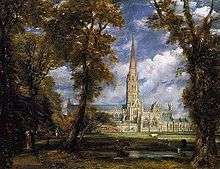

The cathedral is the subject of famous paintings by John Constable. As a gesture of appreciation for John Fisher, Bishop of Salisbury, who commissioned this painting, Constable included the bishop and his wife in the canvas (bottom left). The view depicted in the paintings has changed very little in almost two centuries.
The cathedral is apparently the inspiration for William Golding's novel The Spire, in which the fictional Dean Jocelin makes the building of a cathedral spire his life's work. The construction of the cathedral is an important plot point in Edward Rutherfurd's historical novel Sarum, which explores the historical settlement of the Salisbury area. The cathedral has been mentioned[27] by the author Ken Follett as one of two models for the fictional Kingsbridge Cathedral in his historical novel The Pillars of the Earth. It was also used for some external shots in the 2010 miniseries based on Follett's book and was shown as it is today in the final scene. The cathedral was the setting for the 2005 BBC television drama Mr. Harvey Lights a Candle, written by Rhidian Brook and directed by Susanna White. Kevin McCloud climbed the cathedral in his programme called Don't Look Down! in which he climbed high structures to conquer his fear of heights. The cathedral was the subject of a Channel 4 Time Team programme which was first broadcast on 8 February 2009.
Dean and chapter
As of 14 February 2020:[28]
Burials
Prominent among later burials in the cathedral is Sir Edward Heath (1916–2005), who served as Prime Minister from 1970 to 1974 and as a member of parliament from 1950 to 2001, and lived at Arundells in the Cathedral Close for the last twenty years of his life.[33] Other notable burials include:
- William Longespée, 3rd Earl of Salisbury, (c. 1165–1226)
- Lady Katherine Grey, Countess of Hertford (1540–1568)
- Saint Osmund, Bishop of Salisbury (1078–1099)
- Roger of Salisbury, Bishop of Salisbury (1102–1139)
- Josceline de Bohon, Bishop of Salisbury (1142–1184)
- Robert de Bingham, Bishop of Salisbury (1229–1246)
- Giles of Bridport, Bishop of Salisbury (1256–1262)
- Walter de la Wyle, Bishop of Salisbury (1263–1271)
- Nicholas Longespee, Bishop of Salisbury (1291–1297)
- Simon of Ghent, Bishop of Salisbury (1297–1315)
- Roger Martival, Bishop of Salisbury (1315–1330)
- Walter Hungerford, 1st Baron Hungerford (1378–1449)
- Richard Mitford, Bishop of Salisbury (1395–1407)
- Robert Hungerford, 2nd Baron Hungerford (1409-1459)
- Robert Hungerford, Lord Moleyns and 3rd Baron Hungerford (1431–1464)
- John Cheyne, Baron Cheyne (c. 1442–1499)
- Richard Beauchamp, Bishop of Salisbury (1450–1482)
- John Blyth, Bishop of Salisbury (1493–1499)
- John Doget, Renaissance humanist (died 1501)
- Edmund Audley, Bishop of Salisbury (1501–1524)
- Edward Seymour, 1st Earl of Hertford (1539–1621), nephew of queen-consort Jane Seymour
- Thomas Gorges, (1536–1610) and wife Helena, Marchioness of Northampton, (1548/1549–1635)
- John Jewel, Bishop of Salisbury (1559–1571)
- Edmund Gheast, Bishop of Salisbury (1571–1577)
- Mary Sidney (1561–1621), writer and patron
- William Herbert, 3rd Earl of Pembroke (1580–1630), politician and courtier, buried in a family vault in front of the altar.
- Philip Herbert, 4th Earl of Pembroke
- Philip Herbert, 7th Earl of Pembroke
- Michael Wise (1648–1687), organist and composer
- Alexander Hyde, Bishop of Salisbury (1665–1667)
- John Seymour, 4th Duke of Somerset (before 1646–1675)
- Charles Seymour, 6th Duke of Somerset in the Seymour Chapel (1662–1748)
- John Thomas, Bishop of Salisbury (1761–1766)
Music

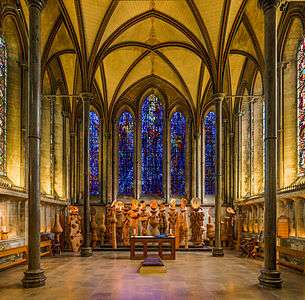
Organ
The cathedral's current organ was built in 1877 by Henry Willis & Sons.[34] Walter Alcock, who was organist of the cathedral from 1916, oversaw a strictly faithful restoration of the famous Father Willis organ, completed in 1934,[35] even going to such lengths as to refuse to allow parts of the instrument to leave the cathedral in case any unauthorised tonal alterations were made without his knowledge,[36] while allowing some discreet additions in the original style of the organ (as well as modernisation of the organ's actions) by Henry Willis III, the grandson of Father Willis.[37]
An earlier organ by Samuel Green was presented by George III in 1792[38] and was installed on top of the stone screen, which, unusually, did not divide the choir from the nave, but rather came from an unknown location in the cathedral.[39] The organ was later taken out and moved to St Thomas's Church.[40]
Organists
It is recorded that in 1463 John Kegewyn was organist of Salisbury Cathedral. Among the notable organists of more recent times have been a number of composers and well-known performers including Bertram Luard-Selby, Charles Frederick South, Walter Alcock, David Valentine Willcocks, Douglas Albert Guest, Christopher Dearnley, Richard Godfrey Seal and the BBC presenter Simon Lole.
Choir
Salisbury Cathedral Choir holds annual auditions for boys and girls aged 7–9 years old for scholarships to Salisbury Cathedral School, which housed in the former Bishop's Palace. The boys' choir and the girls' choir (each 16 strong) sing alternate daily Evensong and Sunday Matins and Eucharist services throughout the school year. There are also many additional services during the Christian year particularly during Advent, Christmas, Holy Week, and Easter. The Advent From Darkness to Light services are the best known. Choristers come from across the country and some board. Six lay vicars (adult men) comprise the rest of the choir, singing tenor, alto and bass parts. In 1993, the cathedral was the venue for the first broadcast of Choral Evensong (the long-running BBC Radio 3 programme) to be sung by a girls' cathedral choir.[41]
Cathedral constables
The cathedral previously employed five cathedral constables (known as "Close Constables"), whose duties mainly concerned the maintenance of law and order in the cathedral close. They were made redundant in 2010 as part of cost-cutting measures and replaced with "traffic managers".[42]
The constables were first appointed when the cathedral became a liberty in 1611 and survived until the introduction of municipal police forces in 1835 with the Municipal Corporations Act.[43] In 1800 they were given the power, along with the city constables, to execute any justices' or court orders requiring the conveyance of prisoners to or from the county jail (at Fisherton Anger, then outside the city of Salisbury) as if it were the city jail (and, in so doing, they were made immune from any legal action for acting outside their respective jurisdictions).[44] The right of the cathedral, as a liberty, to maintain a separate police force was conclusively terminated by the Local Government Act 1888.[45][46]
Peregrine falcons
Between 1864 and 1953, there were records of peregrine falcons being present at the cathedral. More arrived in 2013, and have been hatching every year since, with their nests on the cathedral's tower.[47]
Gallery
.jpg) West façade
West façade- North front
 Trenchard Memorial
Trenchard Memorial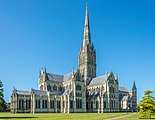 From the northeast
From the northeast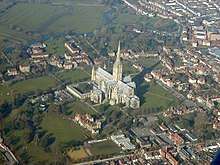 Looking northwest
Looking northwest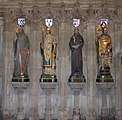 Sculptural detail
Sculptural detail Detail from west front
Detail from west front- The cloisters
- Cloister walk, east side
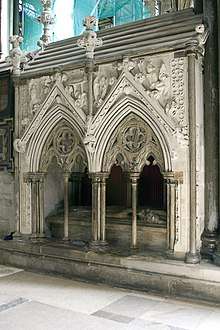 Tomb of Giles of Bridport
Tomb of Giles of Bridport- Choir
- View of the spire from the cloisters
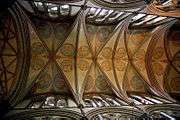 Rib vault ceiling above clerestory windows
Rib vault ceiling above clerestory windows- Lateral view of the west façade
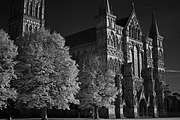 Spire and west façade
Spire and west façade Interior of the spire
Interior of the spire
See also
References and sources
- References
- Blagdon-Gamlen, P. E. (1973). The Church Travellers Directory. London: Church Literature Association. p. 69.
- Ben Sloper. "Salisbury - a Divined Cathedral". Salisbury Cathedral (unofficial). Retrieved 4 June 2020.
- "Visitor Information, Salisbury Cathedral". Archived from the original on 2 January 2008. Retrieved 17 January 2008.
- "Adding the Spire". Salisbury Cathedral Website. 13 September 2018. Archived from the original on 13 September 2018. Retrieved 13 September 2018.
- "Salisbury Cathedral's 750th Anniversary Open Day An Overwhelming Success". Salisbury Cathedral. 28 April 2008. Archived from the original on 8 December 2015. Retrieved 19 October 2015.
- Evans, p. 10-11
- Evans, p. 13
- Ruggles, Ancient Astronomy: An Encyclopedia of Cosmologies and Myth, 2005:225 "A notorious example...a ley line joining Stonehenge (third millennium B.C.E.), Old Sarum (first millennium B.C.E.), and Salisbury cathedral (C.E. 1220)."
- The life of Ela, Countess of Salisbury Wiltshire and Swindon History Centre
- Evans, p. 15
- Sylvanus Urban, wd., The Gentleman's Magazine, and Historical Chronicle (1830), p. 105 Archived 7 March 2017 at the Wayback Machine online at books.google.com
- "The Cathedrals of Britain". BBC History. Archived from the original on 5 January 2018. Retrieved 14 July 2014.
- Ross, David. "Salisbury, Wiltshire". Britain Express. Archived from the original on 14 May 2019. Retrieved 14 May 2019.
- Burke, Dave (20 February 2016). "This 20ft statue had to be moved because people walked into it while texting". Metro. Archived from the original on 4 July 2018. Retrieved 3 July 2018.
- "Man arrested for Magna Carta theft attempt at Salisbury Cathedral". BBC News. 26 October 2018. Archived from the original on 26 October 2018. Retrieved 26 October 2018.
- "Man found guilty of trying to steal Magna Carta". BBC News: Wiltshire. 30 January 2020. Retrieved 31 January 2020.
- Tatton-Brown, Tim; Crook, John (25 June 2009). "Salisbury Cathedral: The Making of a Medieval Masterpiece". Scala Publishers Ltd. p. 70. ISBN 978-1-85759-550-5.
- Rodwell, Warwick; Bentley, James (1984). Our Christian Heritage. George Philip. p. 109. ISBN 978-0540010783.
- Clifton-Taylor, Alec (1970). The Cathedrals of England. Thames & Hudson. p. 105.
- "Salisbury Cathedral". Sacred Destinations. Archived from the original on 23 October 2014. Retrieved 14 July 2014.
- "Salisbury Cathedral". Britain Express. Archived from the original on 4 September 2014. Retrieved 14 July 2014.
- "Salisbury Cathedral's new 'Funky Font'". BBC News. Archived from the original on 23 August 2019. Retrieved 23 August 2019.
- Wright, Michael (15 August 2008). "Salisbury Cathedral: funky font makes a big splash". The Daily Telegraph. Archived from the original on 23 August 2019. Retrieved 23 August 2019.
- "Magna Carta: Where to visit the four surviving originals". 26 January 2015. Archived from the original on 7 June 2019. Retrieved 7 June 2019.
- "Oldest Working Clock, Frequently Asked Questions, Salisbury Cathedral". Archived from the original on 15 June 2009. Retrieved 8 April 2009.
- "Clock repaired, Salisbury Cathedral". Archived from the original on 21 March 2008. Retrieved 17 January 2008.
- Follett, Ken. "Is Kingsbridge Real?". www.ken-follett.com. Archived from the original on 23 June 2012. Retrieved 10 April 2011.
- "Cathedral Chapter". Salisbury Cathedral. Archived from the original on 14 February 2020. Retrieved 14 February 2020.
- "Installation of Canon Nicholas Papadopulos as Dean". Salisbury Cathedral. Archived from the original on 24 December 2018. Retrieved 24 December 2018.
- "Salisbury Cathedral – New Chancellor". Salisburycathedral.org.uk. Archived from the original on 22 June 2013. Retrieved 13 September 2018.
- "New Canon Treasurer appointed". Salisbury Cathedral. Archived from the original on 24 December 2018. Retrieved 24 December 2018.
- "Arundells, Cathedral Close, Salisbury, Wiltshire". www.arundells.org. Archived from the original on 6 June 2017. Retrieved 29 May 2017.
- "Wiltshire, Salisbury Cathedral of the Blessed Virgin Mary". National Pipe Organ Register. Retrieved 10 April 2011.
- Webb, Stanley & Hale, Paul. "Alcock, Sir Walter", Grove Music Online, Oxford Music Online, accessed 1 March 2012 (subscription required)
- Alcock, W. G. "Salisbury Cathedral Organ", The Musical Times, Vol. 75, No. 1098 (August 1934), pp. 730–732 (subscription required) Archived 5 March 2016 at the Wayback Machine
- National Pipe Organ Register N10312
- "Wiltshire Salisbury, Cathedral of the Blessed Virgin Mary [N10306]". The National Pipe Organ Register. The British Institute of Organ Studies. Archived from the original on 15 March 2017. Retrieved 14 March 2017.
- Armfield, A.H. (1890). Cathedrals, abbeys, and churches of England and Wales. London: Cassell & Company. p. 130.
- Cathedrals; 2nd ed. London: Great Western Railway, 1925; p. 33.
- "Timeline of the History of Choral Evensong". BBC Radio 3. Archived from the original on 29 October 2018. Retrieved 16 October 2017.
- Hough, Andrew (6 August 2010). "Anger after Salisbury Cathedral Constables 'scrapped to save money'". The Daily Telegraph. Archived from the original on 25 October 2013. Retrieved 24 January 2011.
- "Salisbury Cathedral Close Constables". Cathedral Constables' Association. Archived from the original on 11 September 2011. Retrieved 24 January 2011.
- "Statute Law Revision: Gaols: Repeal Proposals" (PDF). Law Commission. April 2006. Archived from the original (PDF) on 2 February 2011. Retrieved 17 June 2011.
- section 48(3) Archived 8 December 2009 at the Wayback Machine, Local Government Act 1888
- section 119(4) Archived 8 December 2009 at the Wayback Machine, Local Government Act 1888
- "Peregrine Falcons | Salisbury Cathedral". www.salisburycathedral.org.uk. Archived from the original on 4 July 2018. Retrieved 5 June 2018.
- Sources
- Evans, Sydney. Salisbury Cathedral: A reflective Guide, Michael Russell Publishing, Salisbury. 1985.
- Martín-Gil, J; Martín-Gil, FJ; Ramos-Sánchez, MC; Martín-Ramos, P. The Orange-Brown Patina of Salisbury Cathedral (West Porch) Surfaces: Evidence of its Man-Made Origin. Environmental Science and Pollution Research, 12(5):285–289. 2005.
External links
| Wikimedia Commons has media related to Salisbury Cathedral. |